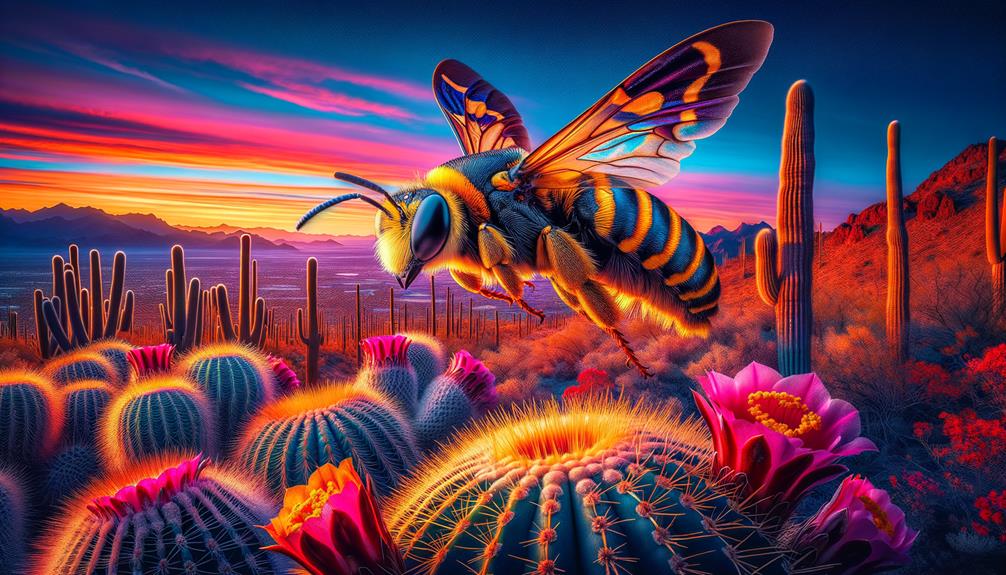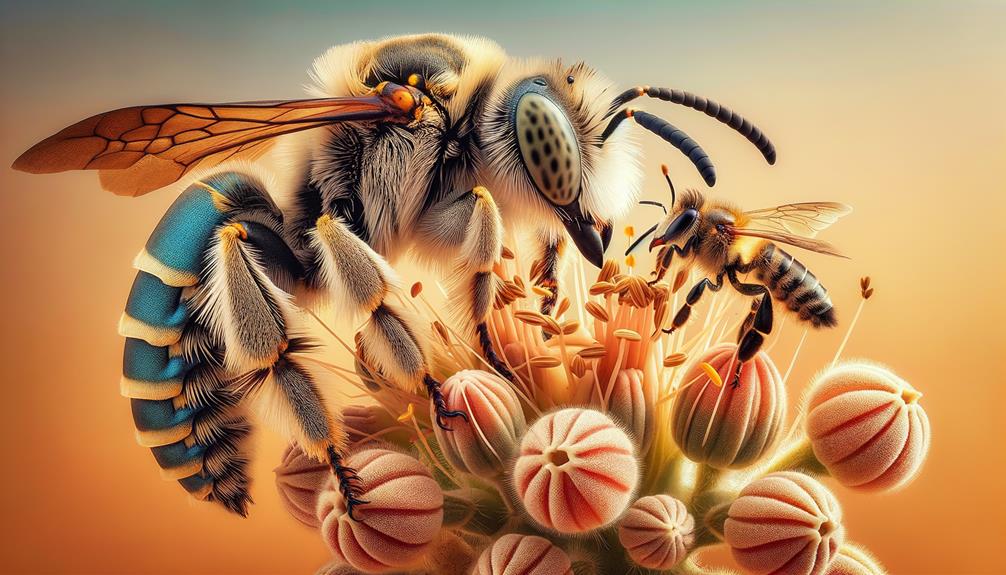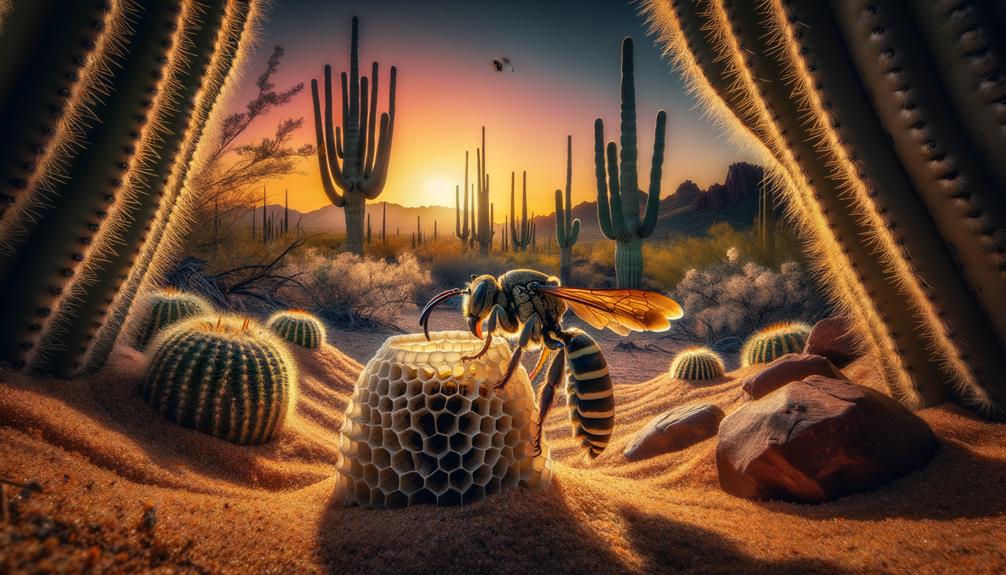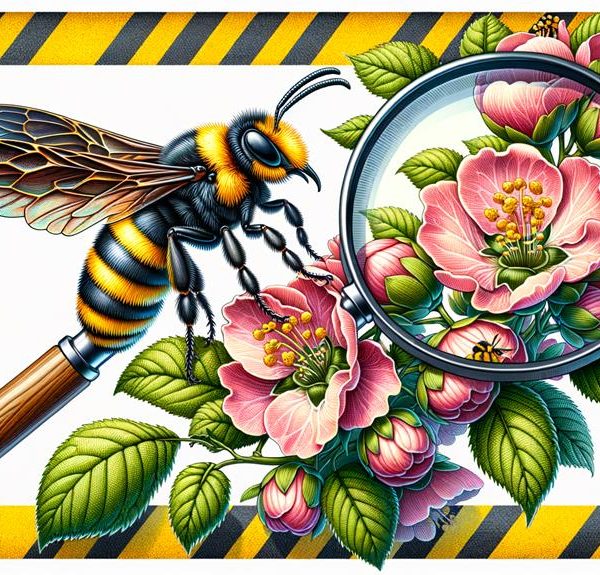Learn about Arizona's unique cuckoo bees, their survival tactics, and why their existence is crucial to other bee species.

Cuckoo Bees in Arizona
Did you know, in the world of bees, there's an equivalent of the old horse and buggy days?
It's the intriguing life of the cuckoo bee, particularly those found in Arizona.
You'd be surprised to learn how these bees have evolved to survive without the burden of pollen collection or hive building.
They've developed a fascinating, yet somewhat notorious, lifestyle that's deeply intertwined with the survival of other bee species.
As we explore further, you'll discover why the survival of these freeloading bees matters more than you might think.
Understanding Cuckoo Bees

Diving into the world of Cuckoo Bees, you'll discover that these intriguing insects are known for their unique parasitic lifestyle, laying their eggs in the nests of other bee species instead of building their own. In Arizona, they're abundant, with their stealth and cunning making them a fascinating subject of study.
Because they don't collect pollen like regular bees, you'll find that Cuckoo Bees have smooth, shiny bodies. They're kleptoparasites, meaning they steal provisions collected by their hosts, which often leads to the death of the host larvae. Cuckoo Bees usually target solitary bees, as they lay single eggs in their nests without any workers to guard them.
Their life cycle is a bit of a puzzle. After laying eggs, the Cuckoo Bee larvae develop large, sickle-shaped mandibles. They use these to destroy the host larvae and eggs. Then, they consume the food stored in the nest. By understanding this, you can better appreciate the role Cuckoo Bees play in the ecosystem. Although they may seem destructive, they're simply another cog in the complex and fascinating machine that's nature.
Cuckoo Bees' Unique Lifestyle

When you delve into the unique lifestyle of Cuckoo Bees, you'll find that their parasitic behavior, which includes a lack of nest-building and the stealing of provisions from their unsuspecting hosts, is a fascinating adaptation designed for survival. These bees are named after the cuckoo bird, which is known for similar behaviors.
This lifestyle allows Cuckoo Bees to conserve energy and resources. They don't need to collect pollen or nectar, nor do they have to construct and protect nests. Instead, they infiltrate the nests of other bee species, laying their eggs and leaving their offspring to be raised by others.
Let's break down this process:
Action | Outcome |
|---|---|
Infiltration | Cuckoo Bees sneak into the nests of unsuspecting host bees. |
Egg-laying | The Cuckoo Bee lays her eggs in the host's nest. |
Dependency | The host bee raises the Cuckoo Bee's offspring, usually at the expense of their own. |
Survival | This strategy ensures the survival of the Cuckoo Bee's lineage. |
Cuckoo Bees in Arizona's Ecosystem

Often overlooked, Cuckoo Bees play a vital role in Arizona's ecosystem, engaging in complex interactions that significantly impact the biodiversity and health of local environments. They contribute in ways you mightn't expect, from pollination to the maintenance of a balanced insect population.
These bees have a unique ecological role, as they're cleptoparasites. Instead of building their own nests, they take over the nests of other solitary bees, laying their own eggs in the host bee's nest. This might seem like a destructive behavior, but it's a natural form of population control, ensuring that no single species becomes too dominant.
To fully understand their importance, let's consider some key aspects of their impact:
- Pollination: Despite their parasitic lifestyle, Cuckoo Bees still collect pollen for consumption, inadvertently participating in pollination.
- Biodiversity: Their presence encourages a more diverse bee population by keeping host populations in check.
- Food Chains: They form a part of the food chain, serving as prey for predators.
- Natural Balance: Their parasitic behavior aids in maintaining a natural balance within the ecosystem.
In essence, Cuckoo Bees are integral to Arizona's lively and varied ecosystem. Their presence, though often unnoticed, is vital and multi-faceted.
Protecting Arizona's Cuckoo Bees

Given their vital role in the ecosystem, it's crucial that we prioritize the protection of Arizona's Cuckoo Bees. You play an essential part in this as well. It's not enough to merely appreciate their ecological importance; we must take active measures to ensure their survival.
Firstly, you can limit pesticide use in your gardens and landscapes. Pesticides are a primary threat to these bees, disrupting their feeding and breeding patterns. Opt for natural, bee-friendly alternatives instead. Don't overlook the importance of native plants in your landscapes, either. These plants provide vital nectar and pollen sources for Cuckoo Bees.
Secondly, you can promote public awareness about the Cuckoo Bees' role. Many people aren't aware of their significance in the ecosystem. By educating others, you're aiding in the preservation of these species.
Lastly, support local and national conservation efforts. Many organizations work tirelessly to protect these and other pollinators, and they could use your help.
Let's not forget that the protection of Arizona's Cuckoo Bees isn't just about preserving a species; it's about safeguarding the ecological balance. By taking these steps, you're contributing to a more sustainable future for all of us.
Fascinating Cuckoo Bee Facts

Here are five captivating facts about Cuckoo Bees that you mightn't know, highlighting their unique biological features and intriguing behaviors. As you delve into the world of these fascinating creatures, you'll uncover a scientific treasure trove of information.
- *Parasitic Lifestyle*: Unlike other bees, Cuckoo Bees don't build their own nests. They're known as 'brood parasites,' laying their eggs in the nests of other bees. Their offspring then consume the host's food and often the host's larvae.
- *Camouflage Ability*: Cuckoo Bees are masters of disguise. They often resemble their hosts in coloration and size, allowing them to infiltrate nests undetected.
- *No Pollen Collection*: Female Cuckoo Bees don't possess the specialized hairs for pollen collection found in other bees, due to their parasitic lifestyle.
- *Specialized Morphology*: Cuckoo Bees have thicker exoskeletons and are more heavily armed with spines and hooks than other bees. This helps them to survive attacks from their host bees.
It's clear that Cuckoo Bees aren't your average pollen-collecting insects. From their parasitic lifestyle to their specialized morphology, they've evolved a unique set of characteristics to survive in the competitive world of bees.
Conclusion
You've delved into the captivating world of Arizona's cuckoo bees. They lead a unique lifestyle, playing a vital role in our ecosystem. Protecting them isn't just about saving bees; it's about preserving biodiversity.
Remember, these fascinating insects aren't just intriguing for their parasitic behavior. They're a key thread in the intricate web of life, highlighting the importance of every species in our environment.
So, let's take steps to safeguard these remarkable creatures for future generations to study and admire.



